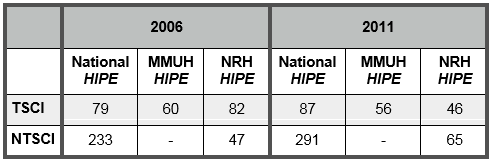Use of HIPE coding for spinal cord injury
Sir,
The epidemiology of traumatic spinal cord injury (TSCI) in Ireland requires updating; the only previous study was carried out in 20001. There have been no studies on epidemiology of non-traumatic spinal cord injury (NTSCI). These studies are necessary to contribute to the global mapping projects2,3 and locally, for service development. While awaiting prospective epidemiological data, we considered retrospective data collection. We used the national Hospital In-Patient Enquiry (HIPE) to estimate incidences of TSCI and NTSCI and thereby guide us in deciding if population-based retrospective studies were possible. Incidence of TSCI can be approximated from data collected and cross-checked between the National Spinal Injuries Unit, Mater Misericordiae University Hospital (NSIU, MMUH) and National Rehabilitation Hospital (NRH), as all surviving cases of TSCI are referred to one or both institutions. However, gathering information on NTSCI incidence is more challenging such is the range of conditions that it encompasses4 and the fact that all cases are not referred for specialist rehabilitation at the NRH.
This table displays the number of cases of TSCI & NTSCI discharged from hospitals in 2006 and 2011, based on data from national-HIPE, MMUH-HIPE and the NRH-HIPE
TSCI – traumatic spinal cord injury; NTSCI – non traumatic spinal cord injury; HIPE – Hospital In-patient Enquiry;
MMUH – Mater Misericordiae University Hospital; NRH – National Rehabilitation Hospital.
Here, discrepancies in the figures are noted for both conditions in the 2 years sampled. It would be expected that figures from the 3 data sources for TSCI should approximate but not be exactly equal, for the following reasons: a small number of patients with TSCI are not managed in the NSIU, MMUH e.g. if severe traumatic brain injury co-occurs; death occurs in a small number of patients before reaching MMUH or NRH; a small number recover adequately in the acute phase of care and do not require specialist in-patient rehabilitation; there could be inconsistencies in coding practices. The discrepancy in the figures for TSCI for 2006, probably reflects a system of day-case/short-stay re-admissions to NRH for clinical reviews, not available since 2008 due to reconfiguration of services within the hospital.
The substantial discrepancy between national-HIPE and NRH-HIPE for NTSCI suggests that there are many more incident cases per year of NTSCI than those referred to the NRH. This is not surprising in view of the broad range of congenital, genetic and acquired conditions which are included under the term NTSCI4. It is also well recognised internationally that coding for NTSCI using administrative databases is more challenging than for TSCI5.
We concluded that a complete set of population-based retrospective data on TSCI incidence could be collected from MMUH-HIPE and NRH-HIPE, as figures approximate with national-HIPE data. However, use of the NRH-HIPE as a reflection of incidence of NTSCI would be unlikely to provide accurate information such is the gap to national-HIPE figures. National-HIPE was useful in guiding the design of a 6 year retrospective study of TSCI, 2010 – 2015.
E Smith1,2, P Fitzpatrick3
1 National Rehabilitation Hospital, Dublin
2 Mater Misericordiae University Hospital, Dublin
3 UCD School of Public Health, Physiotherapy & Sports Science.
Correspondence to: Dr. Éimear Smith, National Rehabilitation Hospital, Rochestown Ave.,
Dun Laoghaire. Co. Dublin
Email: eimear.smith@nrh.ie
References
- O’Connor RJ, Murray PC. Review of spinal cord injuries in Ireland. Spinal Cord 2006;44:445-448.
- Lee BB, Cripps RA, Fitzharris M, Wing PC. The global map for traumatic spinal cord injury epidemiology: update 2011, global incidence rate. Spinal Cord 2014;52:110-116.
- 3. New PW, Cripps RA, Lee BB. Global maps of non-traumatic spinal cord injury epidemiology: towards a living data repository. Spinal Cord 2014;52:97-109.
- New PW, Marshall R. International spinal cord injury data sets for non-traumatic spinal cord injury. Spinal Cord 2014;52:123-132
- Guilcher SJ, Parsons D, Craven BC, Jaglal SB, Verrier M. Developing quality of care indicators for patients with traumatic and non-traumatic spinal cord injury: a feasibility study using administrative health data. J Spinal Cord Med 2015;38:765-776.

